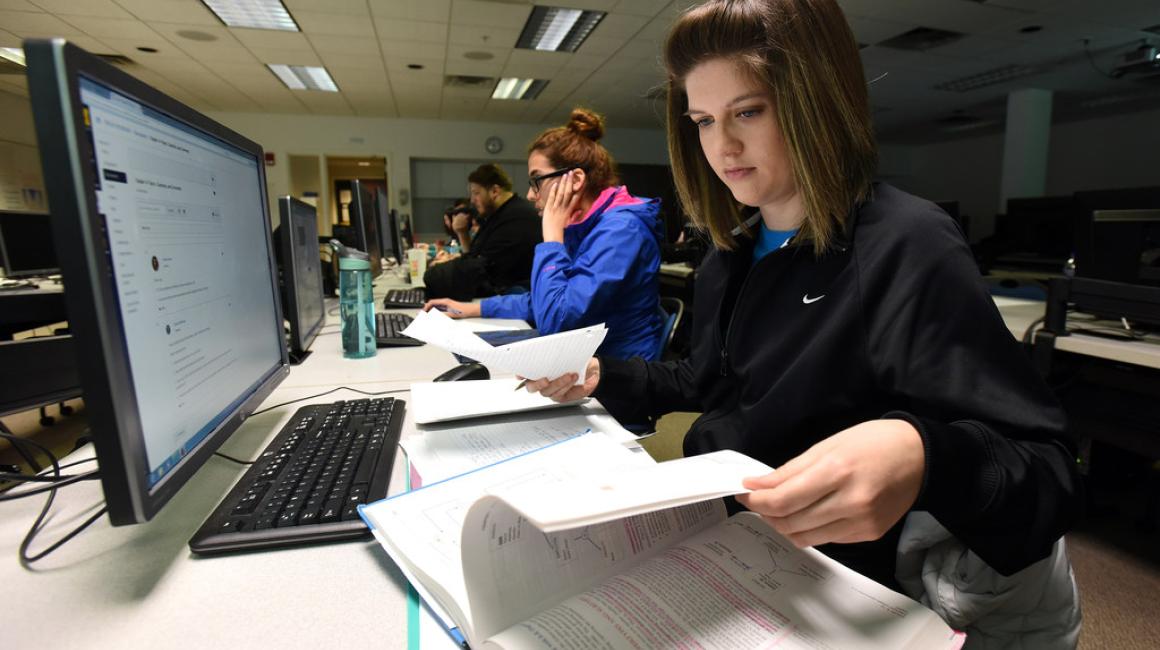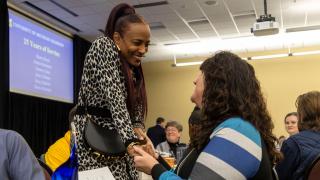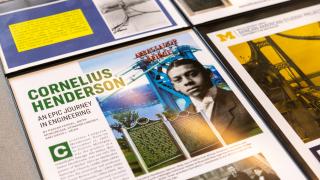
Some UM-Dearborn students need to take classes during the day while their young child is in school. Others want to find a night class to fit their work schedule. And there are students who seek out hybrid courses for more flexibility.
Through a customized survey taken by students in the fall — the UM-Dearborn Student Experience Survey — Dearborn Wolverines shared their needs when it comes to their college education. At the top of the list: the time, frequency and ways courses are offered.
Associate Provost Mitch Sollenberger said the survey, which will be administered on a regular basis moving forward, was designed to assess what student needs are at this moment in time to help shape conversations about UM-Dearborn’s future.
“It is vital that we alleviate campus-related challenges that hinder students’ progress toward graduation, ”Sollenberger said. “The survey is just one part of an ongoing conversation that’s happening around campus to ensure we are living up to our mission of being a caring, inclusive, student-focused institution.”
A cross-campus team is leading the way in creating centralized campus resources. Along with Sollenberger, members include University Coordinator of Digital Education Chris Casey, Political Science Associate Professor and Assessment Subcommittee Chair Emily Matthews Luxon and Director of the Hub for Teaching & Learning Resources Carla Vecchiola.
Team members recently shared a few highlights from the survey and solutions that have been developed, as well as challenges and how the campus is working to address those.
Students want more options when scheduling.
Solution: There’s a new guide to help faculty and leadership think about scheduling from a student perspective.
Can a student finish a degree program if they need to take all online classes? Can they earn their diploma through only enrolling in for evening courses? And, if not, what can be done to help?
To help facilitate conversations around questions like these at college and department levels, the team created a Guide for Evaluating Program Schedules & Modalities. It’s based on a strategic priorities report that was developed by the team from Student Experience Survey data. If a one-pager is more your style, they made one of those too.
Luxon said they developed the guide to give suggestions to colleges and departments on how to evaluate complicated processes like scheduling. “As a faculty member, I know we are focused on student needs. But sometimes we might not realize that if a specific course is always offered on a Tuesday and only in the fall, we might be creating bottlenecks that make it challenging for our students to complete their degrees in a shorter period of time,” Luxon said. “Each college knows their students best and will make their own decisions, but we wanted to offer a centralized resource that can assist in learning what students need and ways we can adapt.”
This is especially important for UM-Dearborn students because they have many competing priorities. Data shows that many UM-Dearborn students are PELL-eligible and are first-generation college students. And through interactions with their students, faculty members often hear that Dearborn Wolverines work while going to school and/or are family caregivers.
Sollenberger said there may not be obvious answers, but the guide is an invitation to think about the role each class plays in the bigger picture.
One suggestion is for departments to create a degree pathway for programs and identify potential degree bottlenecks. For example: If one faculty member teaches a specialized course, what’s the plan if they go on sabbatical? Or what happens if a student transfers to UM-Dearborn in the fall, but a class they need to move forward in the degree program is only offered in the winter?
“We are providing the support for people to have the discussion,” Sollenberger said. “Whatever we do, it will be a process of listening, learning and adapting. And that makes sense because education is always a continued process.”
Waitlists can cause bottlenecks when earning a degree.
Solution: A database is underway to give faculty more access to information that will help them plan for the more in-demand courses.
The UM-Dearborn community is focused on getting students to graduation as quickly as possible. However, waitlists for a needed class may impact a student’s graduation timeline.
To help alleviate this, Casey is working with the Office of Institutional Research and Effectiveness to create a data warehouse that will collect snapshots in time of data and enable the university to generate reports on data like waitlists, which are currently discarded each semester. Other reports, like a degree audit exception and DEW rates (grades D, E and withdrawal), also will be automated through the database.
“We are developing a dashboard with key data points that can point people to dynamic information needed — like class fill rates and waitlists — when making decisions regarding a particular course or discipline at the college level,” Casey said.
Currently faculty can utilize the course schedule system in Banner to determine fill rates and waitlist information — but that has limitations, said Casey. He said the university recognizes that faculty members need up-to-date data that is easily accessible when it comes to course planning.
One way the new database will help is by showing student demand in real time. If a class has multiple sections and they are offered online and in-person, faculty members will be able to see current fill rates for each modality and section and use the information as one indicator of what students need.
“It won’t tell us the whole story, but it does give measurable points at a particular moment in time,” Casey said. “It’s about optimizing for student demand. Having up-to-date searchable data will help us gauge what students want on a year-to-year basis.”
An initial version of the dashboard should be available by the end of the Winter 2023 semester. An email with more information will be sent to faculty and staff later this semester.
Students want continued flexibility on how their classes are offered — in person, online and hybrid.
Solution: There are campus resources to support faculty in continuing to adapt their classes to the different teaching modalities.
Many students indicated that they would prefer to take a combination of online and in-person classes each semester — and they identified online/asynchronous courses as particularly helpful for reducing scheduling constraints.
To help interested faculty members discover the strengths of each format and learn about useful tools they can use regardless of the course modality, there’s a Course Quality: Best Practices and Resources guide.
Luxon — who has taught online and in-person — said she uses Slack, an instant messaging program and online forum, in her courses, and it works well for her and her students.
“I’m teaching a course that is fully online this semester and was in-person last winter. Slack has been a useful addition to the class. Even though it’s an online tool, when a student was out during my in-person course, it still allowed them to participate in conversations that were going on.”
Sollenberger said the university’s intentional plan to increase online offerings started about a decade ago. And, with it came the realization that faculty would need support in reframing course content to make learning engaging and effective online. The Office of Digital Education began in 2015 and the Hub for Teaching and Learning was founded in 2014, which later added instructional designers in 2016.
“As a campus, we’ve made great strides in this area. The goal for this year is to look at things more holistically when it comes to scheduling courses and program assessment. And for us to think holistically about support systems for teaching and learning,” Sollenberger said. “The Student Experience Survey gave us important information so we have our student needs in mind when strategically thinking about the future.”
Want to learn more or share your insights?
Join a faculty session. These provide an overview of the report and guide and offer discussion opportunities.
- Wednesday, March 8, noon-1 p.m.
- Friday, March 10, 10-11 a.m.
- Tuesday, March 14, 2-3 p.m.
- Thursday, March 23, 9-10 a.m.
Article by Sarah Tuxbury.



